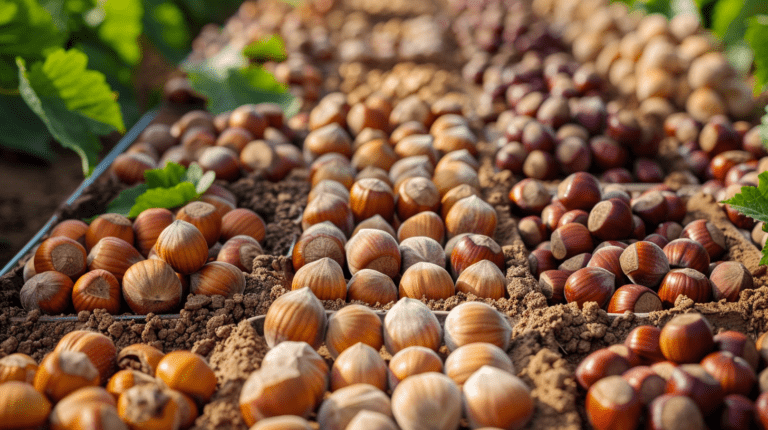Varieties of Hazelnuts: A Comprehensive Guide
Varieties of Hazelnuts
Hazelnuts, also known as filberts or cobnuts, are a highly valued nut crop worldwide. They are celebrated not only for their unique flavor and versatility in culinary applications but also for their nutritional benefits. The diversity in hazelnut varieties makes them suitable for different climates, soils, and market demands. This article delves into the various hazelnut varieties, their characteristics, cultivation requirements, and their market value, offering an extensive guide for growers, researchers, and hazelnut enthusiasts.
History and Origin of Hazelnuts
Hazelnuts have a rich history that dates back to ancient times. They are believed to have originated in Asia Minor and spread throughout Europe and the Mediterranean region. Today, hazelnuts are grown in many parts of the world, with Turkey, Italy, the United States, and Spain being the leading producers. The cultivation and selection of different hazelnut varieties have evolved over centuries, influenced by regional preferences, climatic conditions, and market demands.
Classification of Hazelnut Varieties
Hazelnuts belong to the genus Corylus, which comprises several species. The most commonly cultivated species is Corylus avellana, known as the European hazelnut. Other species include Corylus americana (American hazelnut) and Corylus cornuta (beaked hazelnut). Each species has multiple varieties, bred for specific traits such as nut size, flavor, disease resistance, and adaptability to different growing conditions.
European Hazelnut (Corylus avellana)
The European hazelnut is the most commercially significant species. It is prized for its large nuts and high-quality kernels. Notable varieties include:
1. Barcelona
Origin: Spain
Description: Barcelona is one of the oldest and most widely grown hazelnut varieties. It produces large, round nuts with a thick shell. The kernel has a sweet flavor and a high oil content, making it ideal for confectionery and roasting.
Cultivation: This variety thrives in temperate climates with well-drained soils. It requires cross-pollination and is often paired with pollinizers like Daviana and Ennis.
2. Ennis
Origin: United States
Description: Ennis is known for its large, slightly elongated nuts with a smooth, shiny shell. The kernels are flavorful and have an attractive appearance, making them popular in the nut trade.
Cultivation: Ennis is well-suited to the Pacific Northwest region of the United States. It requires cross-pollination, commonly with Barcelona and Butler varieties.
3. Tonda Gentile delle Langhe
Origin: Italy
Description: This variety is renowned for its small to medium-sized nuts with a thin shell and a high kernel-to-shell ratio. The kernels are prized for their fine flavor and texture, particularly in the confectionery industry.
Cultivation: Tonda Gentile delle Langhe is mainly grown in the Piedmont region of Italy. It prefers well-drained, fertile soils and a mild climate. It requires cross-pollination with varieties like Tonda di Giffoni.
4. Jefferson
Origin: United States
Description: Jefferson is a relatively new variety developed for its high yield and disease resistance, particularly to Eastern Filbert Blight. The nuts are medium to large, with a high-quality kernel.
Cultivation: Jefferson is well-suited to the climate of the Pacific Northwest. It is partially self-fertile but benefits from cross-pollination with varieties like Yamhill and Eta.
American Hazelnut (Corylus americana)
The American hazelnut is native to North America and is more cold-hardy than its European counterpart. It is often used in breeding programs to develop new varieties with enhanced resilience.
1. Grimo 208P
Origin: Canada
Description: Grimo 208P is a hybrid variety developed for its cold hardiness and disease resistance. The nuts are medium-sized with a good kernel quality.
Cultivation: This variety is suitable for colder regions and can thrive in less ideal soil conditions. It is often used in breeding programs to improve resilience.
2. Thebe
Origin: United States
Description: Thebe is a hybrid between European and American hazelnuts, combining the large nut size of the former with the cold hardiness of the latter. The nuts are medium to large with a good flavor.
Cultivation: Thebe is well-suited for colder climates and regions prone to Eastern Filbert Blight. It requires cross-pollination with compatible varieties.
Beaked Hazelnut (Corylus cornuta)
The beaked hazelnut is native to North America and is named for its distinctive beak-like husk. It is less commonly cultivated but is valued for its hardiness and adaptability.
1. Thunderbird
Origin: Canada
Description: Thunderbird is a selected variety of beaked hazelnut known for its small, flavorful nuts. It is particularly valued for its ornamental qualities and wildlife habitat benefits.
Cultivation: This variety is highly adaptable to various soil types and climatic conditions. It is often used in natural landscaping and conservation efforts.
Characteristics of Hazelnut Varieties
Nut Size and Shape
Hazelnut varieties differ significantly in nut size and shape. Larger nuts are generally preferred for commercial purposes due to their higher kernel yield. Round nuts are easier to process and pack, while elongated nuts are often favored for their aesthetic appeal in whole-nut products.
Kernel Quality
Kernel quality is determined by factors such as flavor, texture, oil content, and appearance. Varieties like Tonda Gentile delle Langhe are renowned for their superior flavor and fine texture, making them ideal for confectionery. High oil content is desirable for roasting and culinary uses.
Shell Thickness
Shell thickness affects the ease of cracking and kernel recovery. Varieties with thinner shells, like Tonda Gentile delle Langhe, offer a higher kernel-to-shell ratio, making them more economically viable. However, thicker shells provide better protection against pests and diseases.
Disease Resistance
Disease resistance is a critical factor in hazelnut cultivation. Eastern Filbert Blight (EFB) is a significant threat, particularly in North America. Breeding programs focus on developing varieties with resistance to EFB and other common diseases. Jefferson and Yamhill are examples of EFB-resistant varieties.
Climate Adaptability
Different hazelnut varieties are adapted to specific climatic conditions. European hazelnuts generally prefer temperate climates with mild winters and cool summers. American and beaked hazelnuts are more cold-hardy and can thrive in harsher climates. Understanding the climatic requirements is essential for successful cultivation.
Cultivation Practices for Different Varieties
Soil and Site Selection
Hazelnuts thrive in well-drained, fertile soils with a pH between 6.0 and 7.5. They prefer sites with good air circulation to reduce disease incidence. Selecting the right site and preparing the soil through proper tilling and fertilization is crucial for healthy growth.
Planting and Spacing
Proper planting techniques and spacing are essential to ensure good air circulation and sunlight penetration. Most hazelnut varieties require cross-pollination, so planting compatible pollinizer varieties is necessary. A common practice is to plant main crop varieties with interspersed pollinizers at a ratio of 1:8.
Irrigation and Fertilization
Hazelnuts require consistent moisture, particularly during the growing season. Drip irrigation systems are often used to provide uniform water supply. Fertilization should be based on soil tests, with balanced applications of nitrogen, phosphorus, and potassium to support healthy growth and nut production.
Pruning and Training
Regular pruning and training are essential to maintain tree health, improve sunlight exposure, and facilitate harvesting. Pruning helps in shaping the tree, removing diseased or damaged branches, and encouraging new growth. Training young trees to a central leader or open-center shape is a common practice.
Pest and Disease Management
Integrated pest management (IPM) practices are crucial for controlling pests and diseases in hazelnut orchards. Regular monitoring, cultural practices like removing diseased plant material, and the use of biological or chemical controls help manage common issues like filbertworm, aphids, and EFB.
Harvesting and Processing
Harvesting Methods
Hazelnuts are typically harvested in late summer to early fall when the nuts naturally fall from the tree. Mechanical harvesters are commonly used in commercial orchards, while handpicking is practiced in smaller operations. Timely harvesting is essential to prevent losses from pests and weather conditions.
Post-Harvest Processing
Post-harvest processing involves cleaning, drying, and sorting the nuts. Cleaning removes debris and husks, while drying reduces moisture content to prevent mold and spoilage. Sorting by size and quality ensures uniformity for the market. Proper storage conditions, with low humidity and cool temperatures, extend the shelf life of hazelnuts.
Market Value and Uses
Culinary Applications
Hazelnuts are widely used in culinary applications, from whole nuts and nut butters to flavoring for chocolates and baked goods. Their rich flavor and high oil content make them a favorite in gourmet cuisine and confectionery. Varieties like Tonda Gentile delle Langhe are particularly prized for their fine flavor and texture.
Nutritional Benefits
Hazelnuts are rich in nutrients, including healthy fats, protein, vitamins, and minerals. They are an excellent source of vitamin E, magnesium, and fiber, making them a nutritious addition to a balanced diet. The high content of monounsaturated fats contributes to heart health, while antioxidants provide various health benefits.
Economic Importance
Hazelnuts have significant economic importance in major producing regions. The global demand for hazelnuts continues to grow, driven by the confectionery and snack industries. Countries like Turkey, Italy, and the United States play a crucial role in the global hazelnut market, with exports contributing substantially to their economies.
Emerging Markets
Emerging markets for hazelnuts include Asia and the Middle East, where the demand for healthy snacks and gourmet products is increasing. Innovative products like hazelnut milk and spreads are gaining popularity, expanding the market potential. Sustainability and organic certification are becoming important factors for consumers in these regions.
Conclusion
The diversity of hazelnut varieties offers opportunities for growers and consumers alike. Understanding the characteristics, cultivation practices, and market potential of different varieties is essential for successful hazelnut production. Whether you are a commercial grower or a hazelnut enthusiast, this comprehensive guide provides valuable insights into the world of hazelnuts. By selecting the right varieties and employing best practices, you can enjoy the rich rewards that hazelnuts have to offer.
Hazelnut cultivation continues to evolve with advancements in breeding, disease management, and market trends. Staying informed about the latest developments and adapting to changing conditions will ensure the sustainability and profitability of hazelnut orchards. With their unique flavor, nutritional benefits, and versatility, hazelnuts remain a cherished nut crop worldwide.






